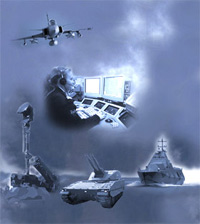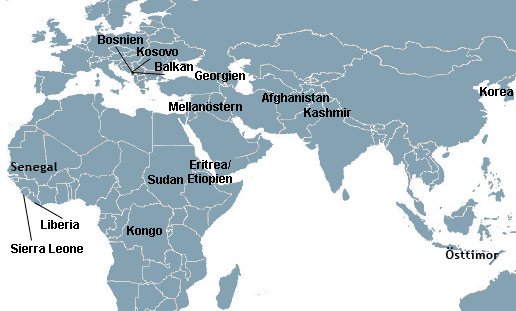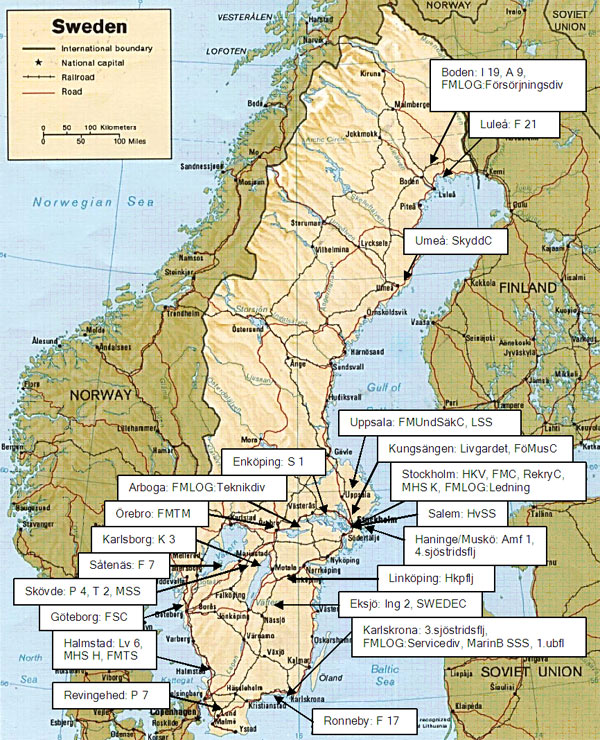
The aims of Sweden´s security policy are to preserve our country´s peace and independence, contribute to stability and security in our vicinity and strengthen international peace and security.
New times, new security policy
Since the end of the World War II, the threat of invasion has passed,
and it no longer seems likely that Sweden would be invaded by another
country. The threats that Sweden now faces are more complex, and are not
limited to military threats alone. Our modern, highly technological society
is vulnerable and could be struck hard by events such as IT sabotage,
natural disasters, ethnic conflicts and nuclear accidents.
Furthermore, new and previously unknown types of threat could arise and
place new demands on the Armed Forces.
The end of the 1990s saw the beginnings of a fundamental re-orientation of the Swedish Armed Forces. The Swedish Parliament and Government conducted a security policy assessment and concluded that for now and the foreseeable future. Sweden is not under threat of invasion, and that the tasks and structure of the Armed Forces must be adapted to suit a new era and a new security policy.
The four main tasks of the Swedish Armed Forces
- To defend Sweden against armed attack
The task of the Swedish Armed Forces is to prepare during peacetime to defend Sweden in war against armed attacks that could threaten our freedom and independence. The Armed Forces are to be able to counter armed attacks regardless of their origin, and to defend the entire country. - To maintain Swedish territorial integrity
The presence of Swedish forces near our borders and in surrounding waters reduces the risk of conflict. In order to maintain our territorial integrity, the Armed Forces use principally air and naval forces. - To contribute to peace and security in the world
Together with other countries, Sweden is to take part in international peace-promoting and humanitarian operations. Since there is always a risk that military conflicts may spread, it is in Sweden´s interests to play a part in resolving conflicts in the world around us. - To assist Swedish society in times of severe peacetime difficulty
The Armed Forces are to make the resources available to support Swedish society in times of severe peacetime difficulty. Effective co-operation with other authorities regarding the utilisation of these resources is vital. Together with the Civil Defence, the Armed Forces must also be able to prevent or assist in managing non-militarydisasters and crises, such as natural disasters, environmental accidents, acts of terrorism and large influxes of refugees.
A flexible defence
The new Armed Forces will be radically different from the previous invasion-oriented defence, since it must be able to execute fast and flexible operations both nationally and in an international context. The new flexible defence and its capabilities are to be adapted to meet a broad spectrum of threats.
For a long time, the Armed Forces were a large organisation in which the number of men, aircraft, tanks, warships, and other equipment was crucial to the ability to counter an invasion. However, for a defence that is to be effective today and in the future, what counts is not so much quantity – that is, sheer numbers of men and their equipment – as the ability to execute operations quickly and flexibly.
The changes mean that elements that no longer fit the new defence concept are to be phased out. New equipment and skills must be developed, and the Armed Forces will be a smaller and more flexible organisation, better adapted to the international sphere.
The Swedish Armed Forces already have highly modern, advanced weapon systems, such as the JAS 39 Gripen aircraft, the Combat Vehicle 90, and the Visby-class Corvette, which are well suited to the new Armed Forces.
Continuous change
These extensive conceptual changes naturally mean that the Armed Forces must implement significant practical adjustments. This work will take time, since the changes encompass many areas – from finances to attitudes and equipment. The pace of change and the methods used to create the new Armed Forces must be constantly tested and adjusted, since the work involved in implementing the changes is highly complex.
An international role
 International
activities are increasing in importance, at the same time as improved
forms of international co-operation are being developed. The commitment
of the Swedish Armed Forces to international causes is nothing new. Since
the creation of the United Nations following the conclusion of World War
II. Sweden has been sending individuals and units on UN peace support
operations in trouble spots around the globe.
International
activities are increasing in importance, at the same time as improved
forms of international co-operation are being developed. The commitment
of the Swedish Armed Forces to international causes is nothing new. Since
the creation of the United Nations following the conclusion of World War
II. Sweden has been sending individuals and units on UN peace support
operations in trouble spots around the globe.
Sweden is a member of Partnership for Peace (PfP), which is a practical co-operation programme between NATO and interested members of the OSCE (Organization for Security and Co-operation in Europe). One cornerstone for the PfP programme is that each country decides in which areas and in which manner it wishes to co-operate. The aims of PfP co-operation include increasing the ability of Sweden to take part in international peace support operations. Sweden also participates in major exercises involving co-operation among many countries to solve fictitious conflicts. Apart from gaining experience in the practical aspects of co-operation and conflict resolution, the participants gain valuable experience through contact with other nations and cultures.
Since Sweden joined the EU in 1995, this too has become an important platform for international co-operation in security.Member States now work together on crisis management issues, which allows Sweden to fully participate in, and gain insight into, EU decision-making. It also places considerable demands on Sweden´s commitment to European co-operation.
Part of a Total Defence Concept
Total Defence consists of both a civil and military part. These two parts work together, and this work is based on the same fundamental needs and concerns. Working together, the civil and military parts of this Total Defence are to be able counter attacks and other serious threats to Swedish security.
Civil Defence includes the whole of society and all its functions. Health services, emergency services, and the supply of power are examples of activties that must continue even when at war. The Civil Defence is thus more than just a public body – it comprises the vital functions of society.
Everyone aged between 16 and 70 living in Sweden must serve in the Total Defence if required, either through military service, civil duty or general service. Approximately 16.000 men and women go through military service annually – enlistment is voluntary for women, obligatory for men, Sweden has decided to retain conscription, even though not everyone who completes the enlistment process will actually be required to attend basic military training.
Sweden´s voluntary defence organisations recruit and train citizens on a voluntary basis, for tasks within the Total Defence. They contribute to the country´s stats of readiness for action within different areas of society.
Staff
Professional officers, reserv officers and civil employees work in the Armed Forces. All of these categories have duties in both peacetime and in crises or war. The combined number of professional officers and civil employees amounts to nearly 20.000, of which just over half are professional officers. The Armed Forces are working diligently to bring more women into the officer corps; today there are about 600 professional and reserve women officers. The approximately 16.000 reserve officers are employed under special agreements and have civilian jobs in addition to the military duties. The civilian employees work in a number of different areas, such as administration, health, technology and logistics.
The Home Guard
![]() The
Home Guard is manned by locally recruited volunteers. It is part of the
Armed Forces organisation and is an important part of the national protection
forces. Its duties are to guard and protect Swedish infrastructure against
sabotage. In addition, its units must be able to perform surveillance
tasks and execute limited combat engineering. It is an important resource
for assisting Swedish society during peacetime.
The
Home Guard is manned by locally recruited volunteers. It is part of the
Armed Forces organisation and is an important part of the national protection
forces. Its duties are to guard and protect Swedish infrastructure against
sabotage. In addition, its units must be able to perform surveillance
tasks and execute limited combat engineering. It is an important resource
for assisting Swedish society during peacetime.
Today´s home guard soldiers undergo a basic military training and use modern equipment. They know their local area and the people who live there well. Home Guard personnel have ordinary civilan qualifications and skills, which are also useful in their home guard activities.
 A
Network Based Defence
A
Network Based Defence
In the future, the Armed Forces must be able to quickly respond to different types of threats and risk. The Swedish Parliament has therefore decided that the Armed Forces are to be developed according to the concept of Network Based Defence.
The idea of Network Based Defence entails a new way of working for the Armed Forces. With greater flexibility than before it will be possible to link together different military functions, such as decision-making, information systems and weapon systems, in a single networked organisation.
This Network Based Defence will provide the basis for an improved understanding of various situations, thus enabling faster decision-making and greater flexibility in combining units and resources to suit whatever task is at hand. Consequently, the Armed Forces will be able to utilise its resources much more effectively than before, putting them to work in the right place at the right time.
The development of a Network Based Defence organisation is important, and will continue for a long time. In order to make the best possible use of future technologies and knowledge – both at home and abroad – the Armed Forces will seek assistance from other authorities, civilian contractors and researchers. There is considerable interest abroad in how Sweden is developing its armed forces. Technological systems are only one part of an improved defence. Thenetwork concept places special demands on the Armed Forces to change the methods of command and control, warfare, and development, but it also calls for a review of the command structure and the proficiencies that future soldiers and the Armed Forces staff will need.
World class defence
Who would have thought, as recently as 15 years ago, that the world would look like it does today? The Warsaw Pact has gone, the Russians are no longer the great threat and the previously Soviet-controlled countries in central and eastern Europe is now member of NATO. And yet it cannot be said that all is well in the world.
New problems have arisen, such as global terrorism, etnic cleansing, refugee disasters, collapsing states, genocide, dissemination of weapons of mass destruction, etc.
In line with European security strategy, we are convering from a large
inventory-backed defence establishment designed to prevent invasion to
a smaller but more active collaborative defence capability. This capability
has to be able to act quickly, coordinately and flexibly in operations
anywhere in the world. By actively participating in the desired international
collaboration to promote peace, we can both contribute to security and
further improve our expertise and ability to deal with future dangers.
Swedish armed forces around the world

What do the armed forces do?
Armed combat is the Swedish armed forces´ unique area of expertise that distinguishes us from other government organisations. Our ability to undertake combat missions needs to be avallable both internationally and at home.
Peace promotion
International operations are now a central part of the Swedish Armed Forces
activities. These operations highlight the need for the smaller and more
flexible defence capability that is beginning to take shape. Swedish forces
have to participate actively in collaboration with other countries in
international, peace-promoting and humanitarien activities. Changing perceived
threats and a new view of European security arrangements are factors underlying
Sweden´s interest in helping to resolve conflicts in the world at
large.
Swedish armed forces 2006

On our own soil
As well as undertaking international operations, the Swedish armed forces watch over Sweden´s territory to detect and repel violations of it, and cooperate with other government organisations to maintain our territorial integrity. Military personnel and equipment may also be used to support Swedish society in peacetime strains and crises.
Keeping up with world developments
If the security situation deteriorates, the armed forces can boosted to counter new and dangerous threats to Sweden´s peace and independence. Basic expertise has to be maintained and it is essential for us to be able to develop more extensive defence capabilities.
Nations need to collaborate to ward off all kinds of threats to peace and security in the world. A lot of work within the EU over the last few years has been put into developing a joint crisis management system. The basic premise is that no country in the world can by itself cope with today´s complex security situation.
Thishas led to the battlegroup concept, whereby EU member countries contribute various capabilities and resources in the form of units trained to take part in rapid joint actions wherever they are needed. The scope of what the battlegroups have to deal with ranges all the way from humanitarian tasks to peace enforcement operations.
By 2008, Sweden is due to have in conjunction with Finland, Norway and Estonia a joint rapid action force, the Nordic Battle Group. As well as quick operations over short periods, Sweden will also need to be able to participate in more long-term peace-promoting operations, and be able to do so anywhere in the world.
Armed forces go abroad
Today´s world is creating new needs that we need to be able to respond to. After many years of respected and valued Swedish operations, the latest being those in Afghanistan, Liberia and Kosovo, our capability and expertise are in demand.
Being able to provide rapid action units and continue to live up to our good reputation involves changes to our compulsory military training. Conscripts will now be offered, after completing their compulsory training, additional voluntary training with international focus. Well-trained volunteer soldiers and the possibility of signing on for longer periods are necessary to enhance Sweden´s ability to take part in international operations. This means that we also need greater expertise in handling increasingly advanced systems here at home.
The main task of the Swedish battalion in Kosovo is to provide security for the local population, a task of vital importance because of the continuing degree of hostility between Serbs and Albanians.
According to the policy decisions taken by NATO and the UN, the Kosovo force is due for gradual reduction. The long-term objective is that KFOR will be completely wound up and the administration of the area will be handed over to its inhabitants.
In the middle of March 2004, disturbances broke out in Kosovo. Swedish
soldiers found themselves at the centre of events.
The attack came as a complete surprise. The soldiers and the UN police
were violently attacked and caught in crossfire when the respective ethnic
groups started shooting at one another with handguns.
KFOR members were forced to shoot the driver of a lorry that tried to run over soldiers in the riot control line. The mob set fire to a Swedish SISU armoured vehicle, which was completely burnt out. The crew were rescued at the last minute. By stubborn resistance we succeeded after more than 12 hours in saving the village from the attack.
Why did we succeed?
I think mainly because our soldiers are very professional and have good
training. The fact that we came out of the situation without serious harm
is also a tribute to the sound judgement of our soldiers and commanders
and their ability to handle an extreme situation. We have good cohesion,
with confidence in our commanders at all levels, and we find it easy to
collaborate with units from other nations.
We need to be prepared to handle situations like this again in the future.
I therefore see a mustering of strength for international tasks within
the Swedish armed forces as a perfectly natural development.
Armed forces in an uncertain world
The restructuring of the Swedish Armed Forces is not a winding down but
rather a development, a development that has already begun and will long
continue.
It is quite impossible to predict the future, but one thing we do know
is that the world is constantly changing and that if we are to play our
part we have to change with it. We have to be prepared for new threats,
dangers and disasters anywhere in the world. In such situations, our job
is to alleviate, fight or help as appropriate.
Askeby storgård 4 juli 2005
Hans Zettby